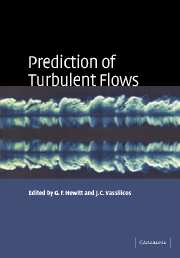Book contents
- Frontmatter
- Contents
- 1 Introduction
- 2 Developments in the understanding and modelling of turbulence
- 3 RANS modelling of turbulent flows affected by buoyancy or stratification
- 4 Turbulent flames
- 5 Boundary layers under strong distortion: an experimentalist's view
- 6 Turbulence simulation
- 7 Computational modelling of multi-phase flows
- 8 Guidelines and criteria for the use of turbulence models in complex flows
7 - Computational modelling of multi-phase flows
Published online by Cambridge University Press: 12 August 2009
- Frontmatter
- Contents
- 1 Introduction
- 2 Developments in the understanding and modelling of turbulence
- 3 RANS modelling of turbulent flows affected by buoyancy or stratification
- 4 Turbulent flames
- 5 Boundary layers under strong distortion: an experimentalist's view
- 6 Turbulence simulation
- 7 Computational modelling of multi-phase flows
- 8 Guidelines and criteria for the use of turbulence models in complex flows
Summary
Introduction
Computational modelling is assuming a greater and greater role in the study of multi-phase flows. Although it is not yet feasible to predict complex multi-phase flow fields over the full range of velocities and flow patterns, computational methods are helpful for a variety of reasons which include:
They enable insights to be obtained on the nature and relative importance of phenomena and are a natural aid to experimental measurement. Indeed, it is often possible to compute quantities which cannot be readily measured.
When coupled with experimental observations and empirical relationships, computational methods can give predictions which are reaching the stage of being useful in the design and operation of systems involving multi-phase flows, particularly for dispersed flow situations. This fact is reflected in the growing number of commercial computer codes which are available for application in this field.
In this chapter, we will deal first with the application of single-phase prediction methods in the interpretation of two-phase flows. Here, a brief description is given of the available turbulence models and examples cited of the application of this approach (flows in coiled tubes, horizontal annular flow and waves in annular flow).
An important class of two-phase flows is that where one of the phases is dispersed in the other, for example dispersions of bubbles in a liquid (bubble flow), dispersions of solid particles in a gas or liquid (gas–solids or liquid–solids dispersed flows) and dispersions of droplets of one liquid in another liquid (liquid–liquid dispersed flow).
- Type
- Chapter
- Information
- Prediction of Turbulent Flows , pp. 236 - 290Publisher: Cambridge University PressPrint publication year: 2005
- 2
- Cited by



